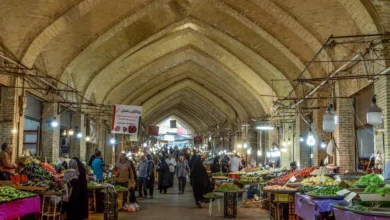Iranian Wildlife and Nature Reserves: A Haven for Biodiversity
Immerse Yourself in the Beauty of this Unique Ecosystem

When it comes to wildlife and landscapes, Iran has it all. We are talking about lush Caspian forests flourishing in the north, endless dunes and deserts baking in the central plateau, and beautiful beaches bordering the Persian Gulf‘s sparkling coast. Home to over 12,000 plant species, 640 bird species, 210 mammal species, and more, Iran’s nature reserves offer a haven for biodiversity amidst a rapidly developing region.
For travelers seeking breathtaking vistas and rare wildlife encounters, Iran’s well-preserved national parks and nature reserves promise unforgettable adventures. Follow this guide to learn about the top must-visit nature reserves across Iran.
Contents
Golestan National Park

The lush Golestan National Park, located in northeastern Iran, was registered as the country’s first national park in 1975. At over 90,000 hectares, Golestan National Park is massive! It protects these extraordinary ancient forests tucked into the Alborz Mountains, the last of their kind left in Iran. The park’s diverse habitat shelters bears, Persian leopards, wolves, deer, and urials. Also, above 140 species of birds can be found in the forest. Golestan’s scenic hiking trails and wildlife diversity made it a UNESCO World Heritage Site.
Lar National Park

Nestled in the misty green foothills of Mount Damavand, Lar National Park offers some of the most spectacular scenery in Iran’s stunning Alborz range. Established in 1976, Lar spans over 30,000 hectares of lush deciduous forest fed by high rainfall. The sanctuary provides critical habitat for brown bears, wolves, boars, and the endangered Persian leopard. Trout swims in the park’s pristine streams, and numerous species of birds inhabit its ancient forests. Visitors can explore Lar’s wildlife and breathtaking vistas through hiking, camping, and nature observation sites.
Urmia Lake National Park

Iran’s largest lake, the stunning Urmia Lake, was designated a national park and UNESCO biosphere reserve in 1976. Over 200 species of birds stop to rest and feed in Urmia Lake’s islands and marshes during seasonal migrations along the Central Asian flyway. Flamingos, pelicans, ducks, storks, and eagles are diverse avian life drawn to the park’s habitats. Urmia Lake’s fragile ecosystem faces environmental threats, but preservation efforts seek to restore the area’s diverse marshes, steppes, and saline landscapes. Responsible ecotourism can support Urmia’s conservation.
Kavir National Park

Kavir National Park, the largest national park in Iran without human habitation, contains vast flat plains covered in steppe and desert greenery. Although the landscape appears barren, the park is an important ecosystem. A total of 34 mammals, 155 birds, and 34 reptile species live in this national park. Access to Kavir National Park is via the road from Varamin to Pishva.
Bakhtgan National Park

Bakhtgan National Park and Wildlife Refuge, located 70 km west of Neyriz in Fars Province, was established in 1995. It covers part of the northern Bakhtgan Lake and is known for its size, biodiversity, and two major lakes. Bakhtgan and Tashk Lakes are among the largest in Iran, situated within the Bakhtgan Refuge. During rainy seasons, the two lakes connect into one vast body of water. This wetland habitat supports nesting and migratory birds, including the endangered Egyptian Vulture.
Khabr National Park

Southern Iran’s arid Khabr National Park highlights the biodiversity of the Baluchistan-Sistan region’s dry tropical forests. Khabr spans a landscape of mountains, plains, and seasonal rivers. Khabr is an essential habitat for leopards, caracals, striped hyenas, chinkaras, wolves, wild sheep, and goats—bird species range from demoiselle cranes to eagles. The Department of Environment offers eco-camping and nature tours to experience Khabr’s wildlife while minimizing its impact on this delicate ecosystem.
Bujagh National Park

Situated where the lush Caspian Hyrcanian forests meet the Caspian Sea’s diverse coastal wetlands, Bujagh National Park protects a mosaic of invaluable habitats. Marshlands fed by a network of rivers attract over 230 resident and migratory birds, including iconic caviar-producing sturgeon. Bujagh was designated Iran’s first mixed terrestrial-marine national park in 2002. Visitors can observe wildlife from observation overlooks, enjoy the coastal scenery, and stroll through Bujagh’s stunning forests.
Sorkheh Hesar National Park

Sorkheh Hesar National Park lies in the Alborz foothills outside Tehran, Iran’s capital. Multiple bird species inhabit the area. The park’s easy access from Tehran makes it a favored spot for hiking and wildlife viewing. The park offers a wilderness escape close to the city. Sorkheh Hesar features arid mountains, forests, and plains.
Turan National Park

Turan National Park is located in the southernmost part of Golestan Province, extending to the eastern extremity of Semnan Province and southeast of Shahroud County, with part of its eastern section falling within Sabzevar County. Extreme temperatures register here, from freezing winters to scorching summers. Hardy desert wildlife like gazelles, leopards, sheep, and goats traverse Tooran’s challenging terrain. UNESCO recognized the park’s fragile ecosystem as a biosphere reserve. Strict regulations limit visitors to the permitted camps and trails. For travelers seeking remote desert adventure, Tooran’s stark vistas and resilient wildlife are unforgettable.
Tange Sayad National Park

Further south, Tange Sayad National Park was registered in 1995 in Chaharmahal and Bakhtiari Province near Shahre Kord City. With a semi-humid, temperate climate, and average annual rainfall, Tange Sayad is also a UNESCO Biosphere Reserve. Plant species include manna, almond, and tamarix trees. Wildlife such as ram, goat, ibex, sheep, leopard, fox, wildcat, Caspian snowcock, golden eagle, partridge, Caspian pond turtle, and leopard snake inhabit the park. The southern mountains and rugged cliffs provide ideal habitat for healthy populations of leopard, ram, and goat. Conveniently located on the edge of the Shahre Kord-Isfahan road, Tange Sayad National Park offers good accessibility.
Persian Wildlife Beyond the Parks
While Iran’s national parks protect habitats critical for conservation, wildlife also thrives across the country’s diverse landscapes. As you travel between Iran’s nature reserves, watch for rare species. Gazelles still roam dry plains and plateaus. Wolves hunt across remote mountains. The gorgeous yellow Asiatic cheetah, reduced to just dozens in the wild, occasionally appears in central deserts. Even city parks and gardens provide habitat for hedgehogs, vibrant birds, and other adaptable species.

Tips for Responsible Wildlife Viewing
To make the most of your visit while minimizing impacts, follow these eco-friendly tips when viewing wildlife in Iran:
- Hire local guides to provide expertise without disrupting animals
- Use binoculars or telephoto lenses rather than approaching animals
- Avoid making loud noises that can disturb wildlife
- Stay on marked trails to protect fragile habitats off-limits to tourists
- Learn guidelines and get permits to enter protected areas
- Avoid picking plants or removing natural objects from parks
- Practice Leave No Trace principles and travel in small groups
- Choose optimal seasons to see species of interest
- Support Iran’s conservation efforts through park fees and local spending
Wrapping up
Iran’s protected areas allow us to experience the beauty and complexity of the natural world. By traveling responsibly, we can help ensure these habitats remain wild and pristine for generations. Have you had memorable wildlife encounters while exploring Iran’s landscapes? Leave your travel tips and stories in the comments!






